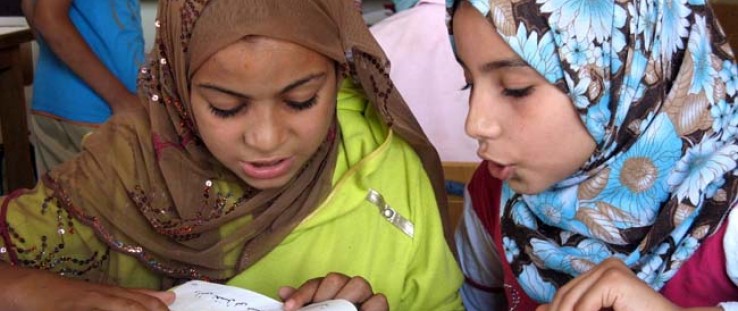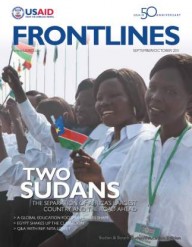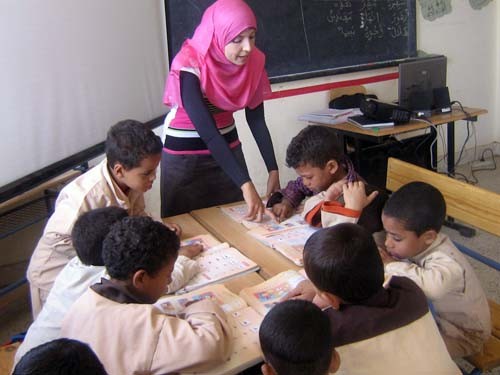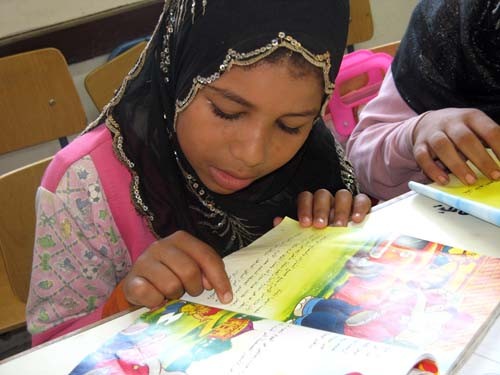 Second grade students who received GILO reading instruction improved their Arabic reading skills much faster than their peers who received tstandard instruction.
USAID
Second grade students who received GILO reading instruction improved their Arabic reading skills much faster than their peers who received tstandard instruction.
USAID
 Second grade students who received GILO reading instruction improved their Arabic reading skills much faster than their peers who received tstandard instruction.
USAID
Second grade students who received GILO reading instruction improved their Arabic reading skills much faster than their peers who received tstandard instruction.
USAID
Up the Nile River and far from Tahrir Square, a quiet revolution is stirring the schools of rural Egypt. Thousands of teachers, intent on invigorating their classrooms, are shaking off stodgy practices and gender stereotypes—and both girls and boys are reaping the benefits.
“I started teaching Arabic 12 years ago,” said Ibrahim Salah, a preparatory school teacher in Beni Suef governorate. “I simply followed the same teaching patterns that I grew up seeing teachers apply; mostly depending on inculcation, without giving students much opportunity to actually participate and to express themselves inside the class.”
Many of Egypt’s schools have promoted the same techniques, with predictable results: disinterested students, frustrated teachers, and low levels of learning, particularly in Arabic reading.
The Egyptian Ministry of Education has recognized such classroom challenges and how they affect enrollment, attendance, and achievement—particularly for girls—in grades one through nine in underserved, rural parts of the country.
To assist the Ministry of Education in responding to these challenges, USAID is working to re-energize thousands of teachers like Salah in their pursuit of educational excellence by injecting an active-learning approach and enhanced reading instruction into the classroom. The flagship initiative, dubbed the Girls’ Improved Learning Outcomes (GILO) project, is currently active in four Upper Egypt governorates.
Students and the Classroom They Create
Since its inception in 2008, the project has trained nearly 9,000 teachers in 340 schools in instructional methods such as dialogue, brainstorming, and role-playing—active learning methods—that move beyond the traditional lecture style to truly engage students. Training has included enhanced classroom management methods such as arranging the classroom to facilitate group work, developing a code of conduct with students to promote a collegial atmosphere, and creating a safe learning environment for girls.
Students have responded.
“Most notably, those who had been performing really poorly—cases I had thought hopeless—their participation increased and their interaction significantly improved,” said Salah.
He noted the case of Salima, a very timid, disengaged 14-year-old girl who he nudged to take part in role play. “She responded very positively to my encouragement and prepared her role [so] well that she astonished her class and me with her performance,” he said.
A 2010 assessment showed the USAID-sponsored training had improved teachers’ application of active-learning practices and classroom management by 68 percent in schools supported by the project over an 18-month period. These practices, in turn, have translated into a livelier learning atmosphere and better attendance—particularly for female students.
Ninth-grade Arabic teacher Attia Awad immediately noticed a difference: “The number of girls attending my class increased notably. Students and I spend the class time in a very energetic and fun atmosphere. The students discover by themselves the new words and their meaning, the ideas in the passage.”
In support of the work GILO has done with teachers over three years, it has also trained nearly 2,300 school supervisors in the same teaching techniques and has empowered the most successful teachers to become coaches or trainers for their peers.
“I was one of the teachers objecting to active learning at the beginning,” said Asharf Samir, an Arabic language teacher in Beni Suef. “But I’m now one of the vocal advocates of these strategies after applying it in my classes and witnessing the impact on students.” Samir joined the first corps of peer trainers in active learning techniques.
“The local community, realizing the change in the attitudes of teachers, students and administrators, has developed respect for the school,” he said.
Sounds and the Words They Make
A little fun and games can go a long way in transforming the learning experience. But, within the active learning framework, the Ministry of Education still has to address one of the biggest deficits in Egypt’s schools: poor performance in Arabic reading.
“We have a lot of evidence that our kids in grades one, two, and three—even grade four—are illiterate,” said Reda Abou Serie, first deputy to the minister of education. “It is a huge complaint all across the country that students are not able to read and write properly.”
Quick Facts on Literacy in the Arab States*
From UNESCO's 2011 Education For All Global Monitoring Report:
- The average literacy rate for women in the region was less than four-fifths that for men in 2008.
- Egypt had the region's highest number of illiterate adults (18 million) in 2006 and accounted for nearly 30% of the regional total.
- Algeria, Egypt, Kuwait and Yemen have increased their adult literacy rates by at least twenty percentage points in the past fifteen to twenty years.
*Algeria, Bahrain, Djibouti, Egypt, Iraq, Jordan, Kuwait, Lebanon, Libyan Arab Jamahiriya, Mauritania, Morocco, Oman, occupied Palestinian territory, Qatar, Saudi Arabia, Sudan, Syrian Arab Republic, Tunisia, United Arab Emirates, and Yemen
Identifying letter sounds is more crucial to decoding words than knowing the letter names. Consequently, more than half of these students could not read a single word in isolation. In grade four, things did not improve: Nearly a third of students could still not read a single word.
“When you have students that are not able to read in grade four, you have something wrong with the approach,” said Abou Serie.
In Egypt’s primary school classrooms, the textbook drives instruction, which focuses on learning letter names and rote memorization of vocabulary words.
“I was always taught that when students know the names of letters they will learn how to read,” said Mansoura Mohamed, a primary school teacher in Minia governorate. “I worked hard on teaching them letter names.” Consequently, progress was slow.
To address this common weakness in most classrooms, GILO designed a package of reading lesson plans that improved the teaching of phonics. The training was rolled out to selected teachers in all four project-supported governorates before the 2010-2011 school year.
“This was a radical change in my understanding and professional experience,” said Mohamed after receiving the training. “Now I know that a main problem in my students’ learning to read is my method of teaching.”
Assessing Progress
USAID’s GILO project conducted a follow-up early-grade reading assessment at the end of the school year to measure the impact of the enhanced teaching method on student learning, assessing all of the same schools from the first testing round, including a set of control schools.
Before the intervention, students in the GILO-supported schools performed at roughly the same level as their peers in the control schools. A year later, preliminary analyses indicate that students in GILO-supported schools identified an average of 19 more letter sounds per minute at the end of the school year, an increase of nearly 200 percent over baseline.
Meanwhile, students in the control group gained just two letter sounds per minute, an increase of only 21 percent over baseline. The impact of the instruction on students’ reading fluency was also dramatic: an average of 10 more words read per minute—an increase of 82 percent over baseline—compared to three more words read per minute among the control group.
And this notable progress came in spite of the fact that the students were out of school for six weeks in the spring semester during the Egyptian revolution.
“[The teachers] told me the phonics method was easy to use, is having a real impact in short time, and that the students enjoy learning in this approach,” Abou Serie said. “It is impressive and that is why we are going to scale it up immediately in the four governorates that GILO is already working in, with plans to roll out training to all schools nationwide.”
Staff from the GILO project contributed to this article.











Comment
Make a general inquiry or suggest an improvement.